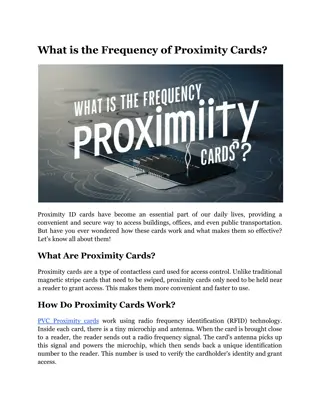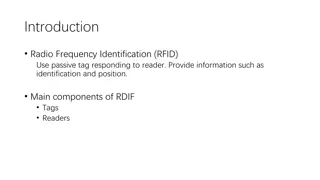
Understanding the Distinctions_ Proximity Cards vs. RFID Technology
Confused about proximity cards and RFID? This guide breaks down the key differences to help you choose the best technology for your needs.
Download Presentation

Please find below an Image/Link to download the presentation.
The content on the website is provided AS IS for your information and personal use only. It may not be sold, licensed, or shared on other websites without obtaining consent from the author. If you encounter any issues during the download, it is possible that the publisher has removed the file from their server.
You are allowed to download the files provided on this website for personal or commercial use, subject to the condition that they are used lawfully. All files are the property of their respective owners.
The content on the website is provided AS IS for your information and personal use only. It may not be sold, licensed, or shared on other websites without obtaining consent from the author.
E N D
Presentation Transcript
Understanding the Distinctions: Proximity Cards vs. RFID Technology In today's rapidly evolving technological world, the terms "Proximity Card" and "RFID" are often used interchangeably. The rapid growth in contactless technology has led to significant advancements in various fields, from security to logistics. Amidst this growth, it is crucial to understand the nuanced differences between proximity cards and RFID (Radio Frequency Identification) technology. Though related, these two technologies have distinct functionalities, applications, and mechanisms. As businesses and individuals increasingly rely on contactless systems for enhanced security and efficiency, distinguishing between these technologies becomes paramount. Defining Proximity Cards and RFID Proximity cards, commonly referred to as prox cards, are contactless smart cards that can be read without the need for physical insertion into a reader device. They operate at a specific frequency, typically 125kHz, and are used extensively in access
control systems. It contains an embedded antenna that communicates with a reader via radio frequency, enabling secure and efficient access to restricted areas. RFID, or Radio Frequency Identification, is a broader technology that encompasses various forms of wireless communication. It involves the use of electromagnetic fields to automatically identify and track tags attached to objects. RFID systems consist of a reader and a tag, where the tag contains electronically stored information that can be transmitted to the reader. RFID operates at multiple frequencies, including low frequency (LF), high frequency (HF), and ultra-high frequency (UHF), each serving different applications. Read More Articles: What Teaching Methods Do Female Quran Teachers Commonly Use? Operational Mechanisms The primary distinction between proximity cards and RFID lies in their operational mechanisms. A 125kHz proximity card, for instance, functions through inductive coupling. When the card is within the reader's electromagnetic field, it absorbs energy from the field, which powers the chip embedded in the card. The chip then transmits its data back to the reader, facilitating identification and access control. This process is inherently secure and suitable for environments where physical contact with the reader is impractical. On the other hand, RFID technology encompasses a broader range of frequencies and mechanisms. LF RFID (125kHz and 134.2kHz) operates similarly to proximity cards, using inductive coupling for short-range communication. HF RFID (13.56MHz) and UHF RFID (860-960MHz), however, employ different coupling techniques and can operate over longer distances. HF RFID uses capacitive coupling, making it ideal for applications like contactless payment systems and smart cards. UHF RFID, with its extended read range, is prevalent in supply chain management, asset tracking, and inventory control.
Applications and Use Cases While both proximity cards and RFID technologies are used in access control, their applications extend to various domains based on their specific capabilities. Proximity cards, particularly the proximity smart card, are ubiquitous in corporate and institutional settings. They are used to grant access to buildings, secure areas, and even computer networks. The convenience of contactless operation and the security features embedded in them make them an essential tool for modern access control systems. RFID technology, with its versatility, finds applications in numerous fields. In addition to access control, it is used in logistics to track the movement of goods, in retail to manage inventory, and in healthcare to monitor patient movements and manage medical equipment. The ability of RFID tags to store and transmit data wirelessly over various distances makes them invaluable for automating processes and enhancing operational efficiency. Read More Articles: IT Support Toronto High-Quality IT support services in Toronto Security Considerations Security is a critical aspect where proximity cards and RFID technologies differ significantly. Proximity cards are designed with security features that prevent unauthorized access. The data stored on the card is often encrypted, and advanced systems incorporate mutual authentication mechanisms, ensuring that only authorized readers can interact with the card. RFID systems, while offering convenience and efficiency, face security challenges due to their broader use cases and varying read ranges. Passive RFID tags, for instance, can be vulnerable to eavesdropping and cloning if not adequately secured. To mitigate these risks, modern RFID systems employ encryption, access control lists, and secure communication protocols.
Bottom Line While both technologies share common principles of wireless communication, they differ in their operational mechanisms, applications, and security features. A proximity card is a specialized form of RFID used primarily for secure access control in corporate and institutional environments. RFID, on the other hand, is a versatile technology with applications spanning various industries, from logistics to healthcare. Need innovative solutions in the field of identification technology? Contact our experts at Bristol ID Technologies to get to know more about our Proximity Smart Cards and RFID access cards! Site Article: Understanding the Distinctions: Proximity Cards vs. RFID Technology





















